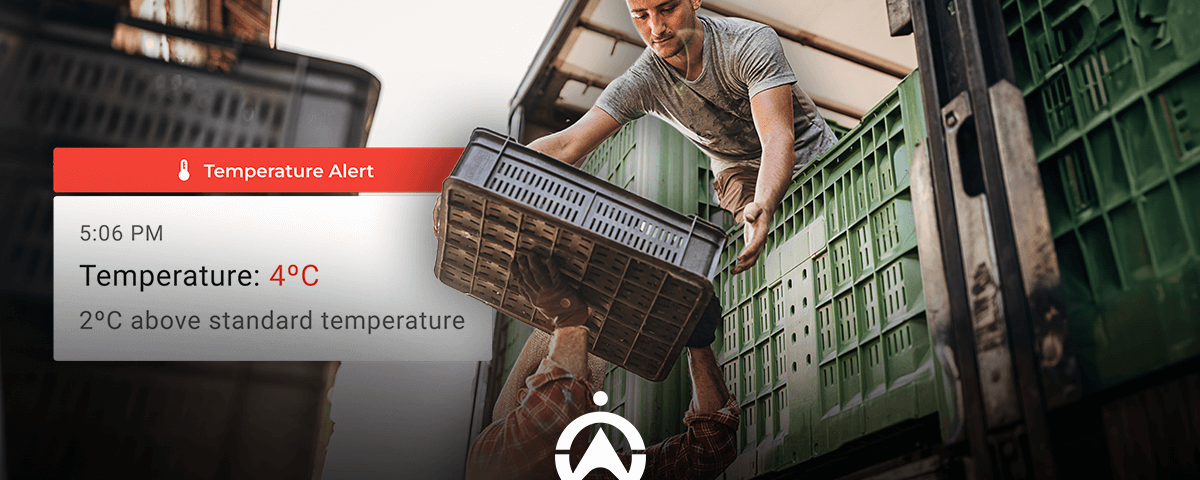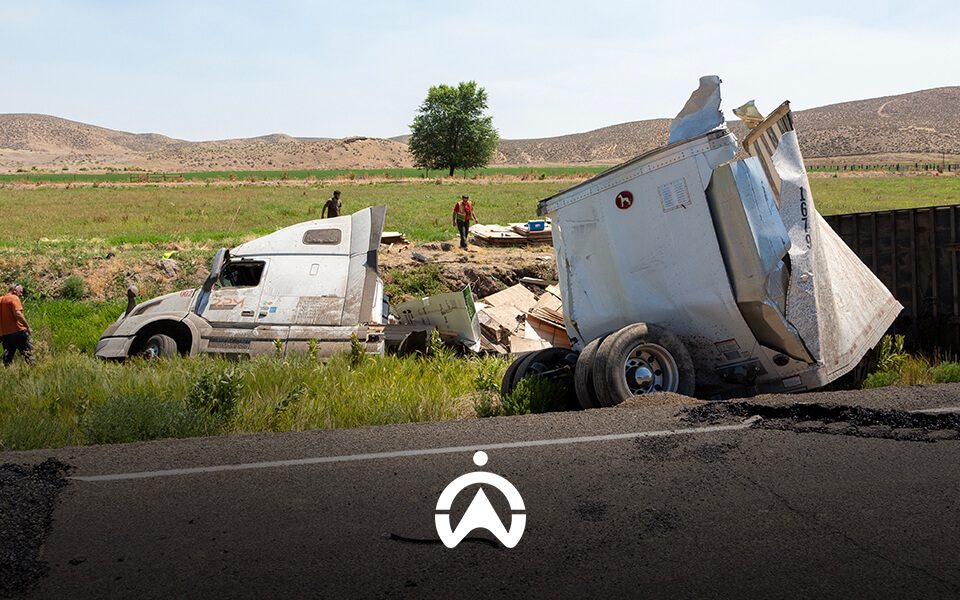How a GPS Tracker with a Temperature Sensor Is the Best Way to Monitor Your Perishables
The quality of perishable goods, such as fruits and dairy products, can spoil quickly without proper storage and transport. This makes them unsafe for use and will cost your transportation business a fortune due to a loss in customer trust and compliance fines.
Managing these goods effectively involves understanding their unique characteristics and implementing suitable storage and transportation practices. Businesses must guarantee safe storage and traceability during the transportation stage to prevent deterioration. To achieve this, there must be a fleet management solution that can monitor the temperature of these perishable goods in transit.
The combination of GPS technology, telematics, and temperature sensors makes this possible, and today, we discuss how it all works and why it’s the best way to monitor your perishables.
What is a GPS tracker with a temperature sensor?
A temperature sensor with a GPS tracker is a device that’s used to monitor temperature readings over a period of time. In cold chain logistics, it’s used to record the temperature conditions of your cargo during transit. This is done through the integration of IoT (Internet of Things) technology, GPS tracking technology, and sensors.
How does the system work?
- Temperature sensors are usually installed in areas inside refrigerated trucks or trailers. The sensors then measure the temperature of that environment, often at frequent intervals (e.g., every 5 minutes).
- Temperature readings are then transmitted to the telematics device for processing, and the device conveys the information to a cloud-based platform in a way that’s easy to understand. This is where fleet managers get notifications of temperature fluctuations.
- The fleet management platform securely stores all temperature-related data for an extended period, giving fleet managers detailed reports that show sensor readings, times, and locations.
What’s the best way to track temperature during transit?
The best way to track the temperature of goods during transit is by using a remote temperature monitor that works in conjunction with a GPS tracking system. This setup offers significant advantages compared to traditional methods, which rely heavily on manual procedures. Such methods are prone to human errors, such as using thermometers and temperature strips.
A GPS tracking system that’s paired with temperature monitors offers real-time temperature alerts with high precision, which minimizes variations. Some sensors are placed in different compartments of the storage unit, which allows multi-point monitoring.
They also give location insights and historical data analysis, which encourages accountability. Furthermore, fleet managers can easily access the data through user-friendly dashboards on desktops or mobile phones.

Why is it important to check the temperature of perishable goods during delivery?
Studies on waste characterization in Eswatini, such as one conducted for the Kwaluseni area, have consistently found that food waste is the largest component of solid waste generated by households. This indicates that a significant amount of food is being discarded, even if the national tonnage isn’t precisely measured.
Eswatini experiences significant post-harvest losses, particularly for fresh fruits and vegetables. Research indicates that these losses can be as high as 50% for certain commodities. This is a critical challenge, as it directly reduces the amount of food available for consumption, even when it has been successfully grown.
Perishable goods such as meat and vegetables have a limited shelf life and must reach retailers in the best quality possible. Storing such goods at incorrect temperatures is one of the most common food safety risks in the cold chain logistics industry, as it can result in bacteria forming, leading to spoilage and food poisoning.
The spoilage of these goods can bring your transportation business significant financial losses and can damage the company’s reputation, potentially leading to product recalls and regulatory fines.
For example, in February 2024, Wazoogle Superfoods recalled some of their peanut butter products that were manufactured between May and December 2023. Tests showed that the products contained aflatoxin levels above safety limits set by regional health authorities. Their investigation revealed that their contract manufacturer had encountered challenges while transporting peanuts from farms in Malawi through Swaziland, en route to South Africa.
This real-life example highlights the dangers and implications of poor temperature monitoring during the transportation stage.
Other industries that benefit most from GPS trackers with temperature sensors?
For most of this article, we’ve spoken about food, but other industries also require temperature monitoring systems, such as the following:
- Pharmaceutical supply and vaccine distribution: Medicines such as tablets, capsules, and vaccines require strict temperature control to maintain their effectiveness. Any temperature fluctuations that occur during transit can alter the chemical structure of these products, making them ineffective or potentially dangerous.
- Floral and nursery: Flowers respond almost immediately to a change in the environment. Some plants and flowers require near-freezing temperatures to survive, while others require warmer temperatures. The floral and nursery industry also uses temperature monitoring systems to maintain temperature ranges during the transportation stage to preserve the quality of flowers and plants.
- Museum and art preservation: Artwork is often sensitive to changes in temperature because of the materials that make up the pieces. For example, a canvas (used for paintings) is made up of natural materials such as cotton or linen. The materials can shrink or expand depending on temperature and humidity, causing permanent damage to the painting. As a result, temperature monitoring during the transportation of valuable artwork is an aspect that shouldn’t be overlooked.
- Funeral services: From hearses to ambulances, it’s important that these vehicles follow safety regulations to ensure slow decomposition, maintain dignity, and avoid health risks while transporting the deceased. Temperature sensors are usually placed inside the coffin compartment of the hearse, and the vehicles usually have GPS trackers for location and timestamps.
How to ensure proper temperature control during transportation
Proper monitoring of perishable cargo involves a collaboration of various technologies, such as the following:
Pre-cooling trucks
It all starts with the type of vehicle you get for the job. Vehicles that transport refrigerated goods have their own specifications. It’s vital to pre-cool the storage compartments to the right conditions before loading the produce. That’s why pre-cooling trucks is a must for most businesses in this industry.
Temperature sensor calibration
Sensor calibration refers to the process of adjusting and setting sensors to measure temperatures accurately. This is done through testing the accuracy of the sensors and adjusting them before placing them into vehicles. Over time, they can give inaccurate readings due to ageing, so they need to be regularly checked and adjusted. Also, make sure the sensors are placed in different zones of the cargo area to get the true conditions of the storage compartment.
Route planning
Another key component in the transportation of perishable goods is planning and choosing routes that minimize travel time to avoid delays that may expose the cargo to risks. The best way to do this is to invest in route optimization software.
Real-time monitoring setup
Set up alerts for fleet managers, coordinators, dispatchers, and all relevant stakeholders so they receive notifications of any temperature changes or route deviations along the way.
Case study: Supermarket Farms
Supermarket Farms supplies fresh, high-quality produce to restaurants, hotels, and catering companies across Eswatini. With over 30 years in the industry, they’ve built a strong reputation for reliability and freshness.
However, they faced challenges in tracking their delivery fleet — they couldn’t see where drivers were at any given time. They needed a system that could provide complete visibility, helping them prevent unnecessary detours or delays. This would ensure that fresh produce reached customers on time while improving overall efficiency.
How we helped them:
- Our GPS tracking solution allows Supermarket Farm to pinpoint exactly where their drivers are at any given time. This helps them see if and why there are delays, such as when drivers are idling for long or when they go off route. If there’re any issues causing delays, they’ll instantly know about and resolve them. They can also alert their own customers, improving their driver turnaround times.
- Supermarket Farm uses our fleet management system to get driver and vehicle insights to help them better run their day-to-day operations. If drivers have received speeding tickets, managers can pull up reports to verify where the event occurred. This helps them to settle disputes, and also minimizes future events from occurring
“Cartrack’s system has benefited our business’ productivity, helping with logistics, and improving driver turnaround times. It has helped us make sure there are no delays and route detours, saving us petrol because the drivers are staying on the exact routes” – Nelson Duarte, Co-owner, Supermarket Farms.

Keep a close eye on your temperature-sensitive goods with Cartrack
Have a look at the features we have in store for your business:
- Temperature sensors
Get up to four temperature sensors to remotely monitor the temperature of your cargo. Receive alerts on any temperature fluctuations and detailed reports. If there are any client complaints, you can use this data to show them that temperatures remained within the compliant range while in transit.
- Cargo door sensors
The frequent opening and closing of cargo doors also contributes to temperature fluctuations and can lead to spoilage. Our cargo door sensors instantly detect when doors open and close. From there, you’ll receive alerts so you can see when drivers do it more often than required, or when doors are open for too long during the offloading stage.
- Live GPS tracking
All businesses in the logistics industry need to invest in a GPS tracking system. Our vehicle tracking system gives you smart map views of your vehicle location, so you always know where they are. You can also spot detours that could cause delays. If drivers are in one spot for too long, you can call to check what’s happening and quickly attend to the matter.
- Route optimization software
You must plan efficient routes for transporting your perishable cargo. Our advanced route optimization software factors in historical traffic patterns, road closures, distance, driver availability, and time. This gives you the best route for each of your deliveries. It ensures that your temperature-sensitive goods arrive on time and in good condition, while helping your business cut back on fuel costs.
Protect your perishable goods with Cartrack’s smart solutions
The integration of GPS technology, telematics, and temperature sensors proves to be an effective way for many businesses in the cold chain industry to monitor their refrigerated cargo. By investing in our preventative solutions, you ensure that all your goods remain in optimal condition from the pickup stage to the drop-off. Keep your cold chain unbroken; contact us today!
Frequently Asked Questions about monitoring perishable goods
How can I monitor temperature remotely?
To monitor temperature remotely, you can use wireless temperature sensor technology that’s integrated with a fleet management platform like MiFleet from Cartrack. This allows you to connect to your fleet’s data from anywhere, whether using a mobile phone or a desktop.
How accurate are temperature sensors?
The accuracy of a temperature sensor depends on the type of sensor it is. Most fleet management services offer BLE (Bluetooth Low Energy) sensors, which are known to be highly accurate. However, like any other gadget, temperature sensors may wear out and lose accuracy over time if not properly maintained.
What device can detect temperature in a cargo truck?
Several devices can detect temperature in a cargo truck. The most common ones include:
- RTDs (Resistance Temperature Detectors): Commonly used in cold chain logistics and conditioning systems.
- Infrared sensors: These work for things like automatic doors and camera motion detection.
- Thermistors: They are used for monitoring the temperatures of oil and coolant in vehicles to ensure reliable engine performance.




